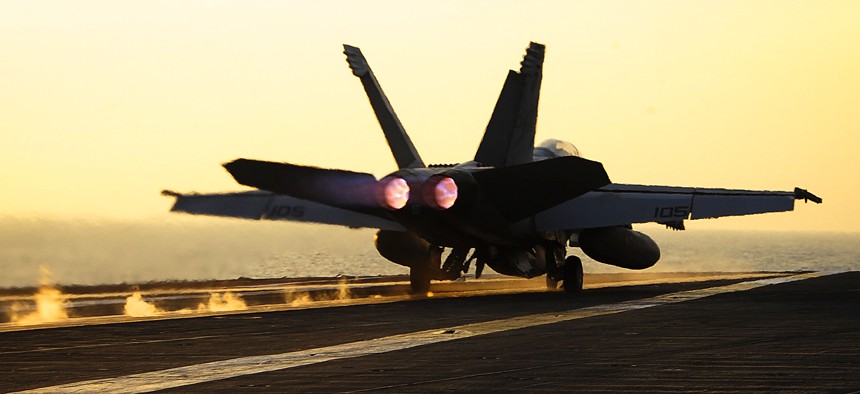
A U.S. Navy F/A-18F Super Hornet launches from the aircraft carrier USS Theodore Roosevelt in the 5th Fleet, Oct. 10, 2015. The aircraft is assigned to Strike Fighter Squadron 11. U.S. Navy photo by Petty Officer 3rd Class Anna Van Nuys
The History of No-Fly Zones Doesn’t Bode Well for Syria
Tough-talking presidential candidates want a no-fly zone to save Syrians. But nothing in the historical record shows a NFZ would work this time.
People have been dying in Syria for years and fleeing in great numbers for months. For all that time, no-fly zones have been urgently called for as morally necessary, yet regularly dismissed as useless, too dangerous, or too costly. Now no-fly zones are being debated in the American presidential campaign. It is time that someone spelled out what the record shows no-fly zones can and cannot do.
Start with the positive:
A no-fly zone can and has stopped a proven and experienced genocidal tyrant. A no-fly zone stopped Saddam Hussein from pursuing a well-developed campaign of murder and brutalization in 1991. But there are important factors to keep in mind. Hussein had just been crushed in the Gulf War. He had no sympathizers. The Kurds were a single, coherent people quite capable of collaborating with outside powers for their own defense. The British were at least as invested as the U.S. in preventing Hussein’s atrocity-in-progress and British and American air and ground forces were, at least for the short term, already deployed to the region.
A no-fly zone can and has been sustained at little cost for long periods—in the case of Iraq, for a dozen years. During that time, one no-fly zone morphed into two, Operation Northern Watch and Operation Southern Watch, and proved useful in containing Hussein, keeping him under close surveillance, coercing him when he excluded UN weapons inspectors, and in providing the means to pummel him and his air defenses when President Bill Clinton felt it appropriate (as he did in December 1998). The no-fly zones kept a UN-authorized American presence in a volatile region.
The cost of the two no-fly zones amounted to about $1 billion per year. Operation Northern Watch flew out of Incirlik, Turkey, and required 40 planes that flew no more than 18 days out of each month (a limit set by their hosts, the Turkish government). Operation Southern Watch flew primarily out of Prince Sultan Air Base in Saudi Arabia and from aircraft carriers in the Persian Gulf.
The number of aircraft and lives lost to enemy action over those dozen years: zero.
These no-fly zones lasted more than a decade, yet brought no protest from the American public. Even though there were stretches in which Saddam’s air defense operators fired on American planes, most Americans were unaware of the operations. (Saddam’s missiles were ineffective because their crews knew turning on their targeting radars would bring an anti-radiation missile, so they fired their weapons as they were ordered to do, but did not stay around to work out a targeting solution.) With no news generated, no-fly zones can stay under the radar of the American public.
Must a no-fly zone be a slippery slope? The ones over Iraq were stable for a dozen years. Are no-fly zones cheap compared to land operations? Three years after President George W. Bush substituted an invasion for no-fly zones, the cost in American lives went from zero to over 4,000 and the cost in dollars leapt to the hundreds of billions. The disruption to the region proved incalculable.
Related: Everything You Need to Know About No-Fly Zones
Related: Defense One's complete coverage of no-fly zones
On the negative side, no-fly zones do not protect noncombatants within reach of a dictator bent on killing them. Four no-fly zones have been established: the two in Iraq, one in Bosnia and one in Libya. In Iraq and Libya, Saddam and Qaddafi could not reach their target victims with their troops. But in Bosnia, Milosevic was unimpeded during much of the no-fly zone enforcement. While Operation Deny Flight flew overhead, Milosevic’s troops seized and slaughtered 8,000 Bosnian men and boys at Srebrenica.
And what of Syria? If the no-fly zone is a humanitarian instrument aimed at saving innocents (as all four no-fly zones have been), it will not be effective because it cannot separate the killers from their victims. Saddam and Qaddafi were constrained by geography: by Iraq’s Zagros Mountains and the Libyan Desert. In Syria, President Bashar al-Assad’s forces, now protected by Russian President Vladimir Putin’s air cover, would have no difficulty reaching the people he intends to kill.
A no-fly zone mixed with the kind of air strikes that worked against former Yugoslav President Slobodan Milosevic in Operation Allied Force over Kosovo in 1999 might hold real promise. If, however, a no-fly zone in Syria is meant to stop Assad, Putin and the Iranians, and provide safe areas for noncombatants, that would be a far more ambitious undertaking. There is nothing in the record of no-fly zones to suggest that would be possible.
Stephen Wrage is a professor of American foreign policy at the Naval Academy. Scott Cooper is a retired Marine aviator who flew in Operations Northern Watch, Southern Watch, Deny Flight, Allied Force, Iraqi Freedom, and Enduring Freedom. Their views are their own and do not reflect their organizations. They are the authors of The Strategy and Politics of No-Fly Zones, forthcoming from Ashgate Press in January.
NEXT STORY: How Drones Make War Too Easy



